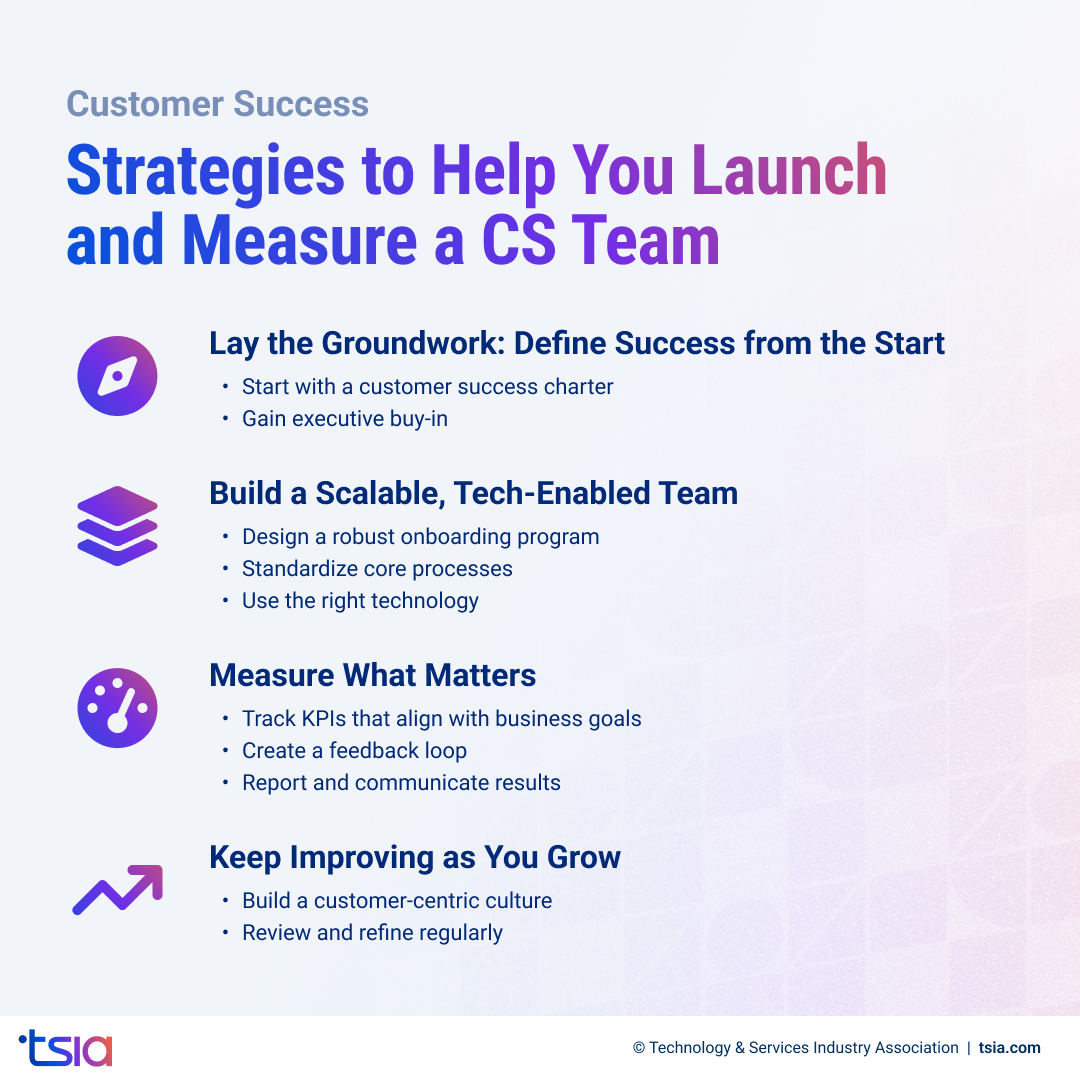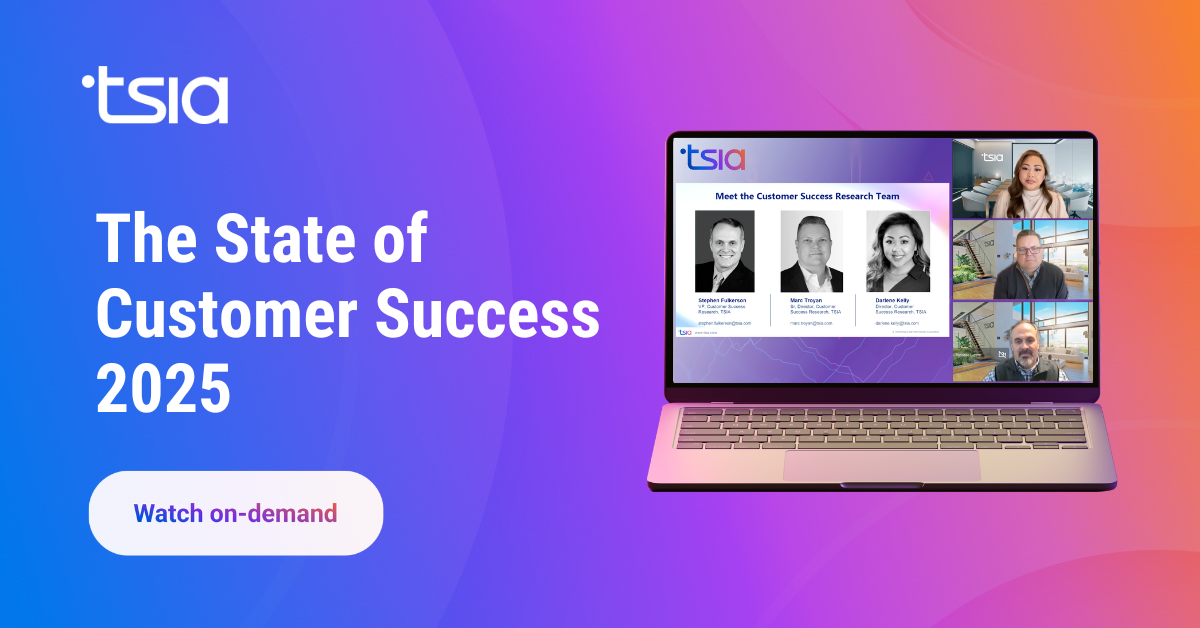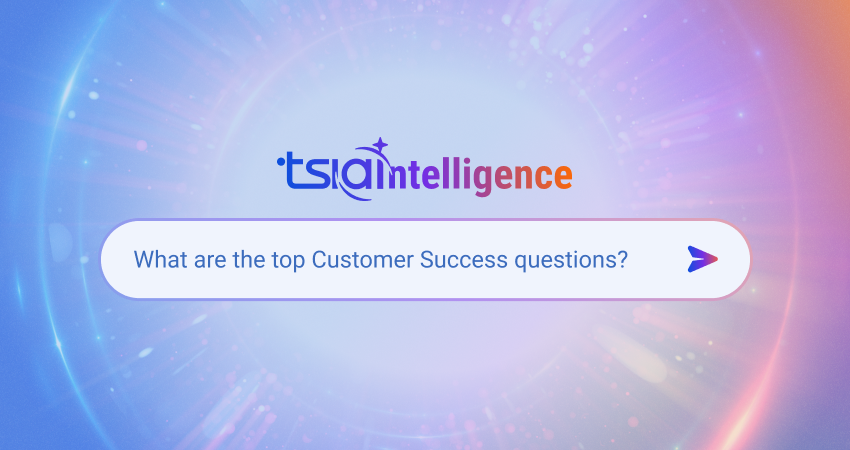If you lead or support customer success at your company, chances are you're facing complex questions about how to drive adoption, measure impact, and scale your efforts. You're not alone.
These are the very questions TSIA Intelligence—AI built exclusively for technology services, within the TSIA Portal—is answering daily for customer success professionals like you. In this blog, we’re highlighting some of the most frequently asked questions in customer success, along with simplified, actionable answers to help you make smarter decisions more quickly.
Whether you're launching a customer success team, optimizing adoption strategies, or aligning with other departments, these insights are here to guide your next move.
Key Takeaways
- A strong customer success strategy starts with a clear charter, cross-functional alignment, and the right tools to scale.
- Adoption frameworks help you understand customer engagement levels and take proactive steps to improve value realization.
- Tracking the right metrics and building a continuous feedback loop are essential to proving—and improving—the impact of customer success.
What Strategies Help You Launch and Measure a Customer Success Team?
If you're building or evolving a customer success team, a structured approach is essential. You need more than just good intentions—you need a strategy that aligns with your company’s goals, clear processes to support your team, and meaningful metrics to track progress. Here’s how to get started and measure what matters.
Lay the Groundwork: Define Success From the Start
Before you begin hiring or setting up workflows, it's essential to have a clear vision.
- Start with a customer success charter: Define your team’s purpose—whether it’s driving adoption, boosting retention, or expanding customer relationships. Your charter should align with company goals and guide how your customer success team operates on a day-to-day basis.
- Gain executive buy-in: Demonstrate the business value of customer success to leadership, with a compelling case that outlines the ROI of it. When you have top-down support, securing resources and driving cross-functional collaboration becomes much easier.
Build a Scalable, Tech-Enabled Team
Once you have the foundation, it’s time to operationalize your customer success strategy.
- Design a robust onboarding program: Equip your customer success team—whether high-touch or tech-touch—with tools and training that cover customer journey mapping, data analysis, and communication strategies.
- Standardize core processes: Create consistent playbooks for customer engagement, segmentation, and health scoring to ensure consistency across all teams. Ensure team roles are clearly defined so that responsibilities don’t fall through the cracks.
- Use the right technology: A customer success platform can help you automate key processes, track customer interactions, and integrate data from across your business. This gives your team a 360-degree view of customer health and engagement.
Measure What Matters
To determine if your customer success efforts are yielding results, you need the right metrics.
- Track KPIs that align with business goals: Start with the basics: churn rate, Net Promoter Score (NPS), customer health scores, and product adoption. These indicators help you understand customer sentiment, usage patterns, and overall satisfaction.
- Create a feedback loop: Regularly gather feedback from customers and customer success team members to ensure ongoing improvement. Apply what you learn to refine processes, enhance training, and improve the overall customer experience.
- Report and communicate results: Share customer success performance data with your stakeholders. Utilize storytelling and visuals to demonstrate how customer success drives revenue, retention, and customer satisfaction.
Keep Improving as You Grow
Customer success isn’t a one-time launch—it’s an evolving strategy.
- Build a customer-centric culture: Make customer success everyone’s responsibility. When departments work together to support customer needs, you create a more cohesive and impactful experience.
- Review and refine regularly: Your customers’ needs will change, and your customer success strategy should too. Set aside time to assess what’s working, what’s not, and how you can better meet customer expectations.
Related: Critical Customer Success KPIs, Metrics, and Health Score Variables

How Does an Adoption Framework Support Customer Success?
If your customers aren’t fully using your product, they aren’t getting the value they signed up for—and that’s where an adoption framework comes in. It provides a structured approach to measuring and improving how customers utilize your product, enabling your customer success efforts to be more proactive, targeted, and impactful.
Understand Where Your Customers Stand
At its core, an adoption framework helps you categorize customer behavior into three levels:
- Low adoption: Minimal usage and low engagement.
- High adoption: Consistent usage, but the customer may not be realizing full value.
- Effective adoption: High usage paired with clear value realization; this is the goal.
By identifying the category a customer falls into, your customer success team can better prioritize outreach and tailor support strategies to enhance outcomes.
Use Data To Drive Smarter Customer Success
An adoption framework is all about collecting meaningful data and acting on it. With the right telemetry and analytics in place, you can monitor usage patterns, identify early signs of churn risk, and pinpoint opportunities to enhance product engagement. This allows your team to:
- Address issues before they impact renewals.
- Fine-tune onboarding and training programs.
- Allocate resources to where they’ll make the most significant difference.
Proactively Strengthen Customer Relationships
With insights from the adoption framework, your customer success team can proactively reach out to customers who need help. Maybe they’re stuck during onboarding or not using a key feature. With the correct data in hand, your team can step in with relevant resources, training, or guidance before issues escalate.
This proactive approach builds trust, increases customer satisfaction, and demonstrates to your customers that you’re invested in their success.
Tie Adoption to Business Results
Effective adoption isn’t just a win for the customer—it’s a win for your business. Adoption metrics directly support key performance indicators, including retention, customer satisfaction, and expansion.
When you can connect customer success activities to measurable outcomes, it becomes easier to justify ongoing investments in your customer success program and prove its value to internal stakeholders.
Related: Adoption Aptitude
Create a Feedback Loop That Fuels Improvement
Customer adoption data should never sit in a silo. A practical framework encourages a continuous feedback loop—where usage data informs your customer success strategy, and your strategy evolves based on real-world customer behavior. This helps you:
- Stay aligned with what your customers need.
- Refine your approach as your product and customer base grow.
- Ensure your customer success strategy is grounded in real-time insights.
Align Across Teams for Greater Impact
Improving adoption is a shared responsibility. A strong adoption framework builds collaboration between customer success and product management by aligning on shared goals:
- Product teams improve features based on real customer usage data.
- Customer success teams develop outreach and support strategies that reflect how customers interact with the product, ensuring a seamless experience.
This alignment helps ensure a seamless customer experience, from product design to post-sale engagement.
Related: Customer Success–Product Management Handshake: A Conversation with Cisco

How To Use These Customer Success Answers To Drive Results
Customer success leaders like you are asking thoughtful, strategic questions, and TSIA Intelligence is here to help you find answers that drive meaningful results. Whether you're building a new customer success function, refining adoption strategies, or proving your team’s impact, the proper guidance can save time, reduce guesswork, and deliver better results.
You don’t have to figure it all out alone. Use these insights as a starting point, and continue exploring the tools, data, and best practices to build a customer success program that drives real value for your customers and your business.
Frequently Asked Questions
What is TSIA Intelligence, and how can it help my customer success strategy?
TSIA Intelligence is an AI-powered tool available in the TSIA Portal that provides quick, research-backed answers to your most challenging customer success questions. It draws insights from TSIA’s extensive library of data, frameworks, and expert research, enabling you to make informed decisions faster and with greater confidence.
How do I know if my customer success team is performing effectively?
Start by tracking key metrics like customer retention, health scores, product adoption, and Net Promoter Score (NPS). But beyond the numbers, effective teams are aligned to a clear charter, have standardized engagement processes, and collaborate closely across departments to drive customer outcomes.
What’s the benefit of using an adoption framework?
An adoption framework helps you identify how deeply customers are using your product, whether they’re underutilizing it, engaging regularly, or truly realizing value. This insight allows you to prioritize outreach, improve onboarding, and tailor support strategies that drive both customer success and business growth.
Smart Tip: Embrace Data-Driven Decision Making
Making smart, informed decisions is more crucial than ever. Leveraging TSIA’s in-depth insights and data-driven frameworks can help you navigate industry shifts confidently. Remember, in a world driven by artificial intelligence and digital transformation, the key to sustained success lies in making strategic decisions informed by reliable data, ensuring your role as a leader in your industry.















